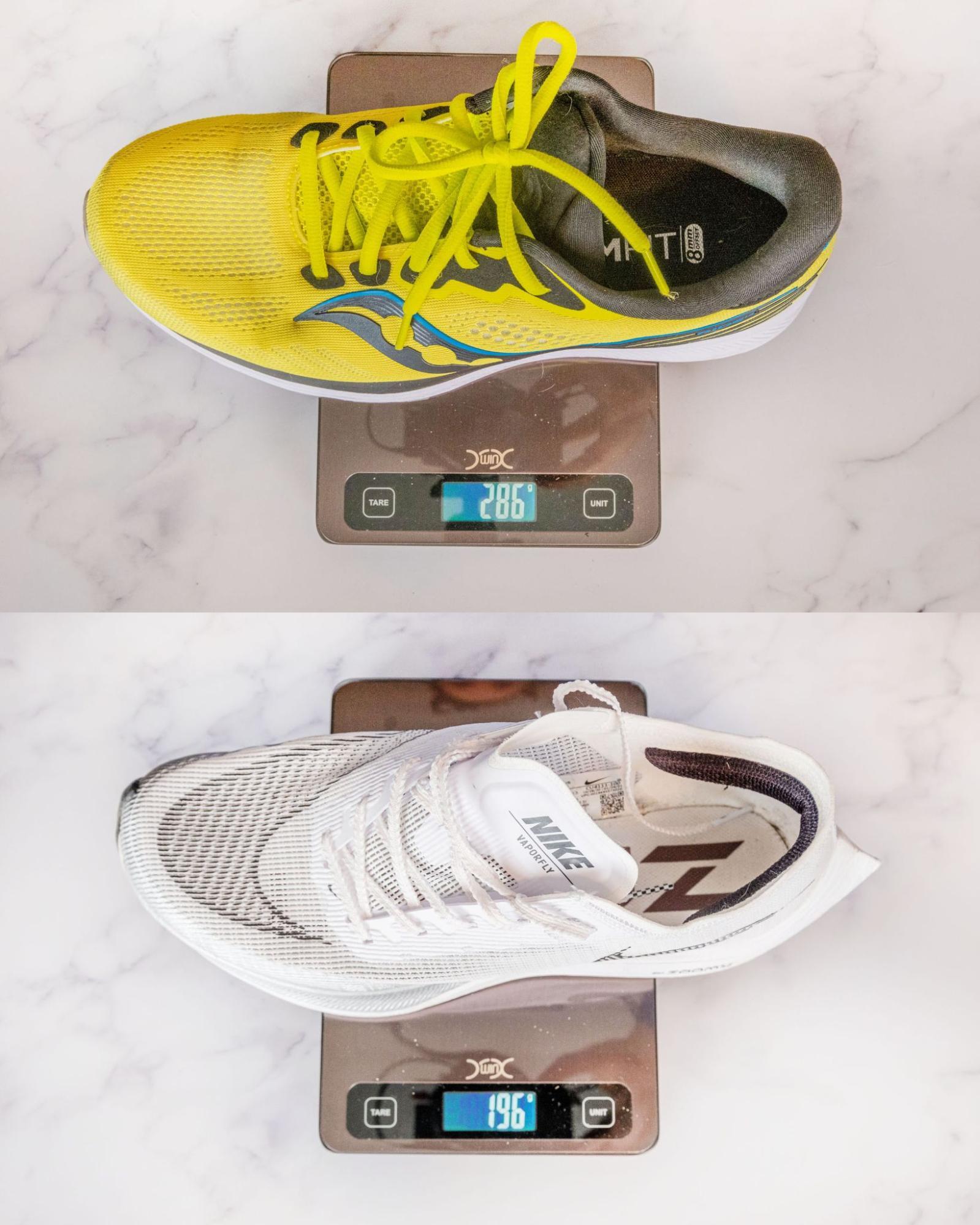Running Shoe Weight & Performance [Calculator]

40+ hours of research and development have been summarised in this in-depth guide. Using our tools, you can find out
- which shoes will get you to your new PB and
- how much faster you can be in shoes that weigh less.
Running shoe weight can definitely affect your running performance. Heavier running shoes are not horrible, and lightweight running shoes are not better. Beginners should choose what works for them and is comfortable.
3 must-know facts about shoe weight
- When you look at weights in the brand’s specifications, keep in mind that they are given for men’s size 9 and women’s size 7.
- Runners aren’t good at telling the difference in shoe weight when running: this study has shown that the accuracy in weight perception by the feet was only 30% while the accuracy in weight perception by the hand went as high as 92%.
- Bulkier (high-stacked) shoes aren’t always heavier due to new technologies and especially carbon-plated midsoles.
- It's possible to estimate the weight of any shoe size by adjusting the weight by 2.6% for every half size up from the base weight. We've explained this in great detail in our article on weight change across different shoe sizes.
How much does shoe weight affect performance?
The most usual answer: adding 100g or 3.5oz per shoe will slow you down 1%.
Researchers have put this to the test and they went to show similar results (we calculated the slowdown for 3.5oz heavier shoes if not already given):
| Slowdown | How the test was performed |
| 0.22% | The study looked at the results on 1 mile (1.6km) when decreasing the shoe weight by 1oz: runners were 0.83s slower. |
| 0.78% | The slowdown for every 3.5oz added while running 3000m (source) is 2min18s. |
| 1.56% | Nike’s calculation for marathon runners running in 4oz lighter shoes: they could finish 3 minutes faster. |
This study from 2020 showed that adding 100g per shoe impairs running economy and performance in trained runners without changes in gait characteristics or neuromuscular variables. These findings further support the use of light footwear to optimise running performance.
The challenge is that you can’t keep going lighter and lighter. At some point, you get slower because there’s simply not enough cushioning. Cushioning can improve your running economy by 3-4%. To prove it’s about cushioning and not something else, researchers have shown that cushioning the ground with 10mm EVA foam gives you the same benefits.
Tool: How faster can you run and in which shoes?
Pros and cons of different running shoe weights
Here we will cover all 3 groups: lightweight, average and heavy running shoes.
Lightweight running shoes
Weight: <8.8oz | 250g
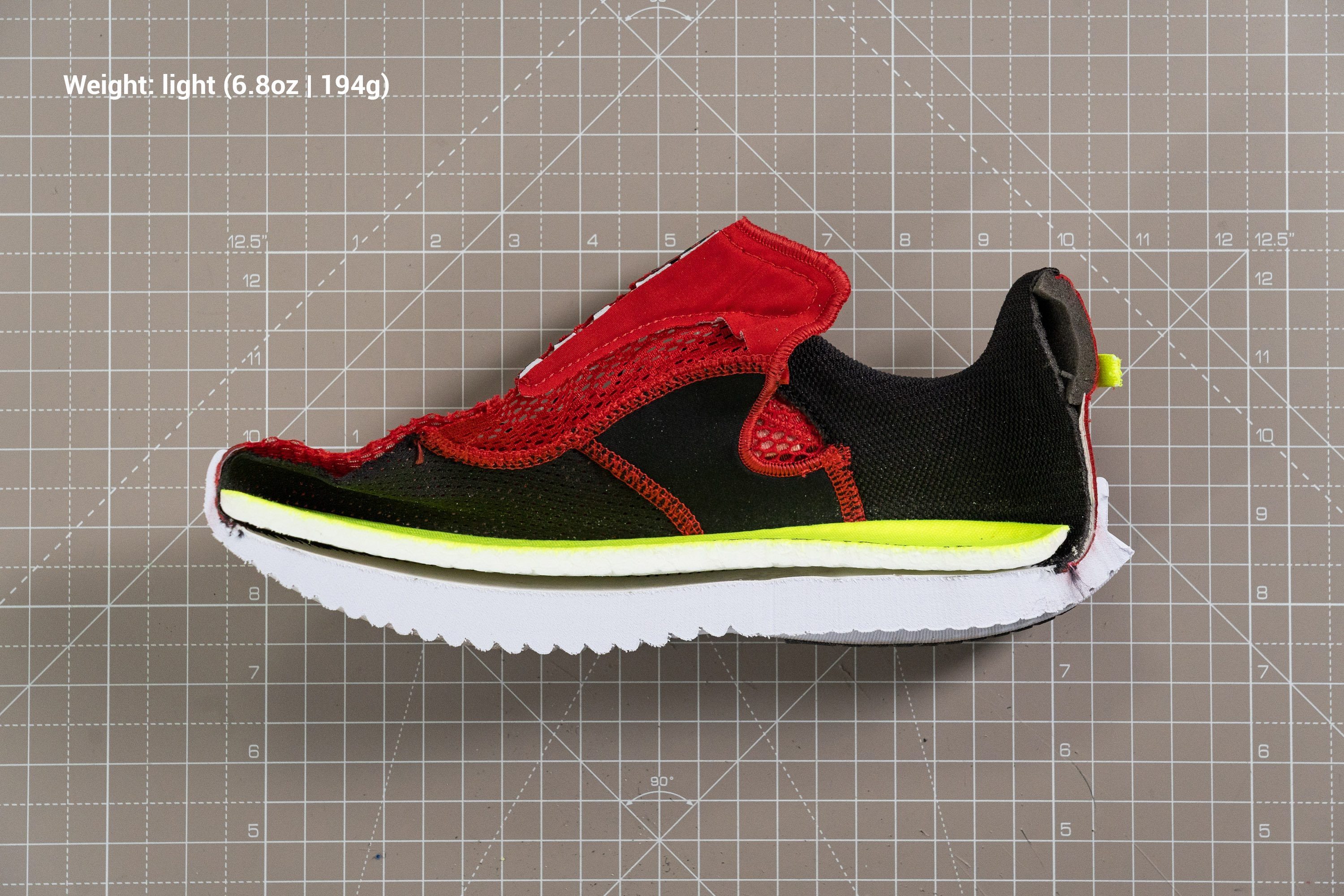
Pros of lightweight running shoes
- You can barely feel them
- More natural feeling
- Better for speed work and races
Cons of lightweight running shoes
- Less durable
- Less or no support
- Not for heavier runners
Average-weight running shoes
Weight:~9.3oz | 265g
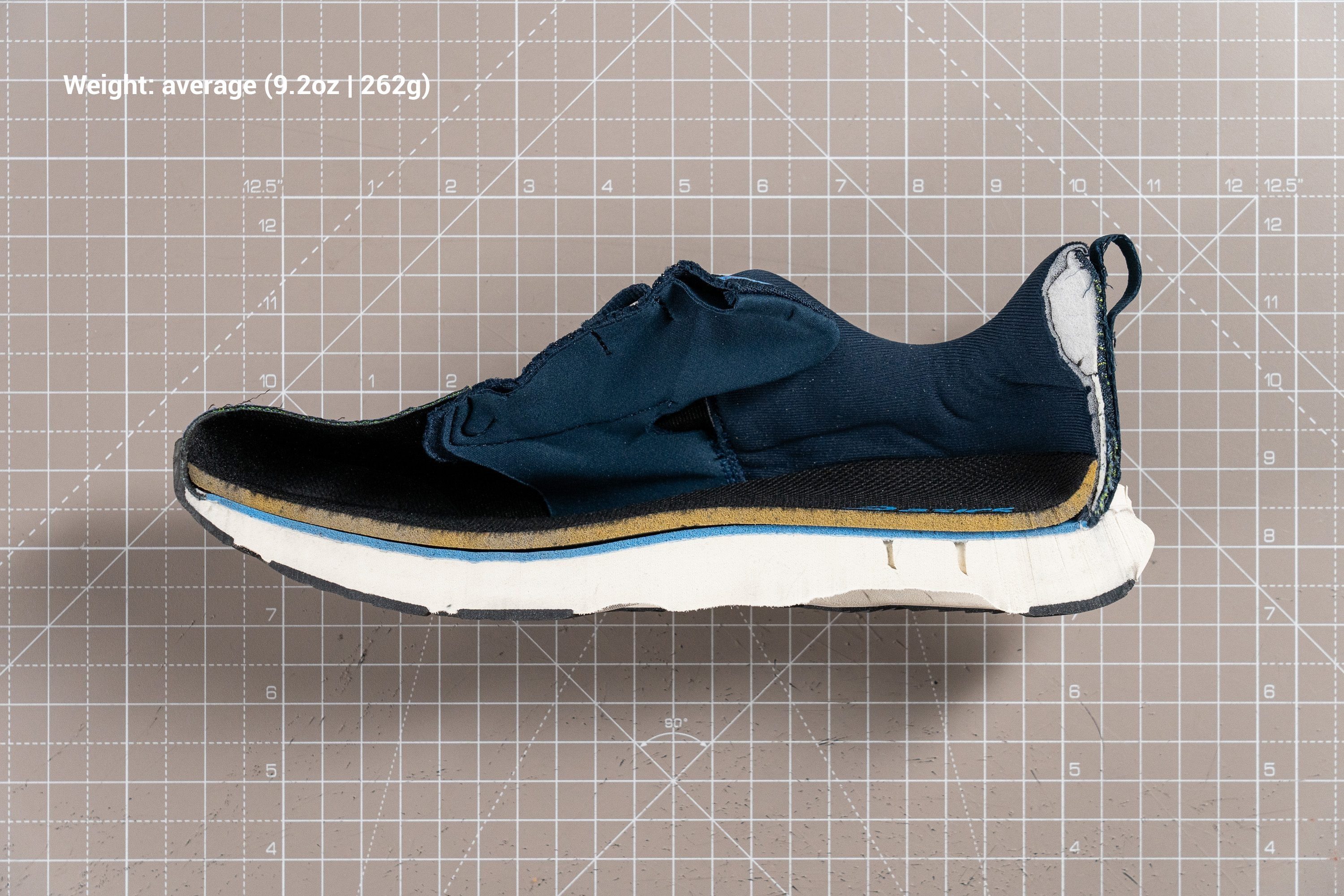
Pros of average-weight running shoes
- Versatile
- One shoe for all types of runs
Cons of average-weight running shoes
- Not the best for highly specific runs
Heavy running shoes
Weight: >10.6oz | 300g
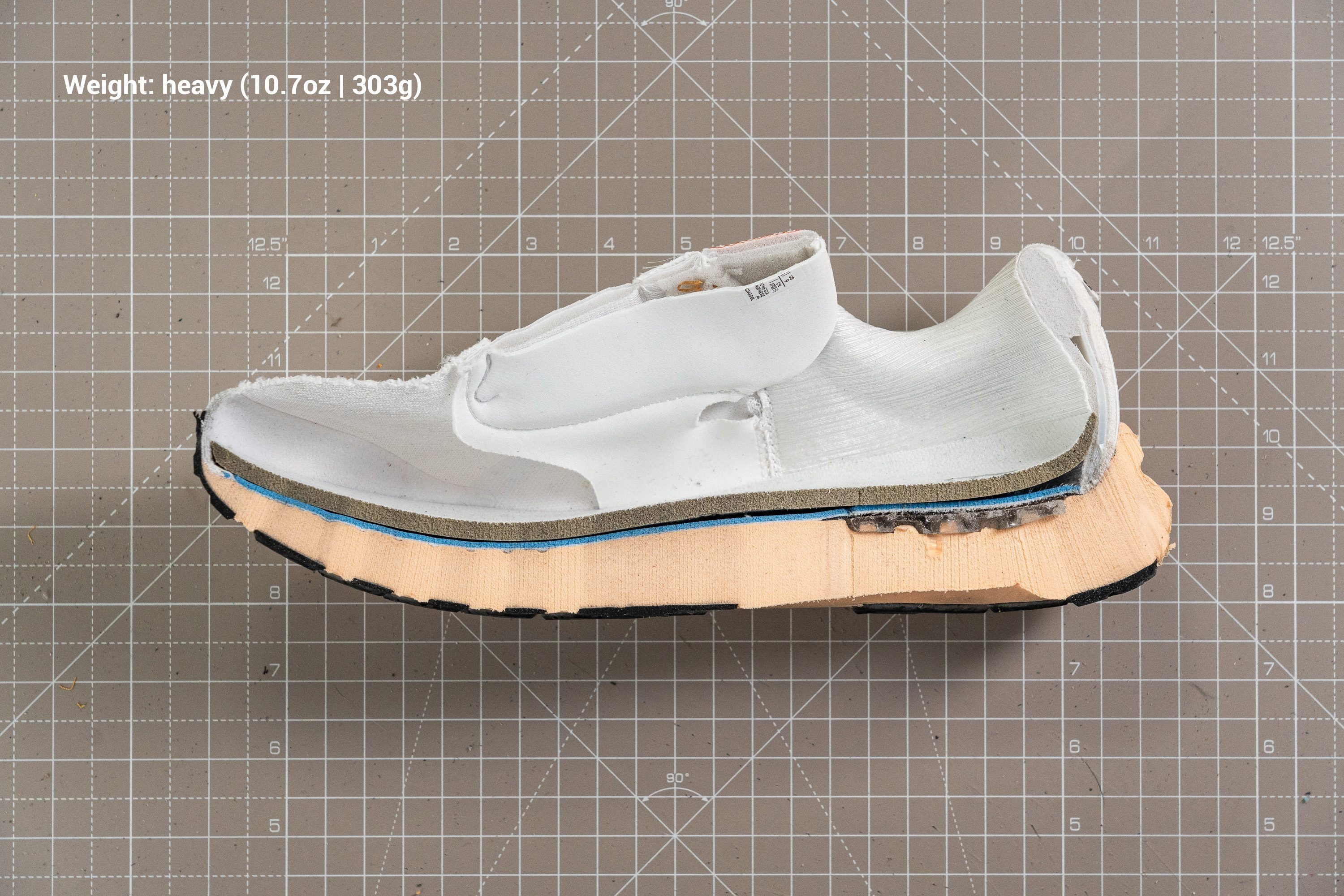
Pros of heavy running shoes
- Durable
- Cushioned
- Stability features often included
- Protective features
- Good for heavier runners
Cons of heavy running shoes
- Heavy
- Might cause foot fatigue
- No natural feeling
Scientific research has shown that:
- Wearing lightweight shoes may promote calf muscle fatigue. This might suggest that an adaptation period is needed when changing from heavy to lightweight shoes.
- When running a 5k, minimalist shoes improve running performance (economy and finish time).
- The 26-week study found that runners with a bodyweight of more than 85 kilograms and training in lightweight running shoes were over 3x more likely to sustain an injury than when wearing conventional running shoes.
- Runners who are new to running in a maximal shoe may be at an increased risk of injury.
- Maximalist shoes won’t necessarily improve your running economy.
Which shoe weight is better for you?
This depends on many factors. Mainly it’s about your priorities and preferences.
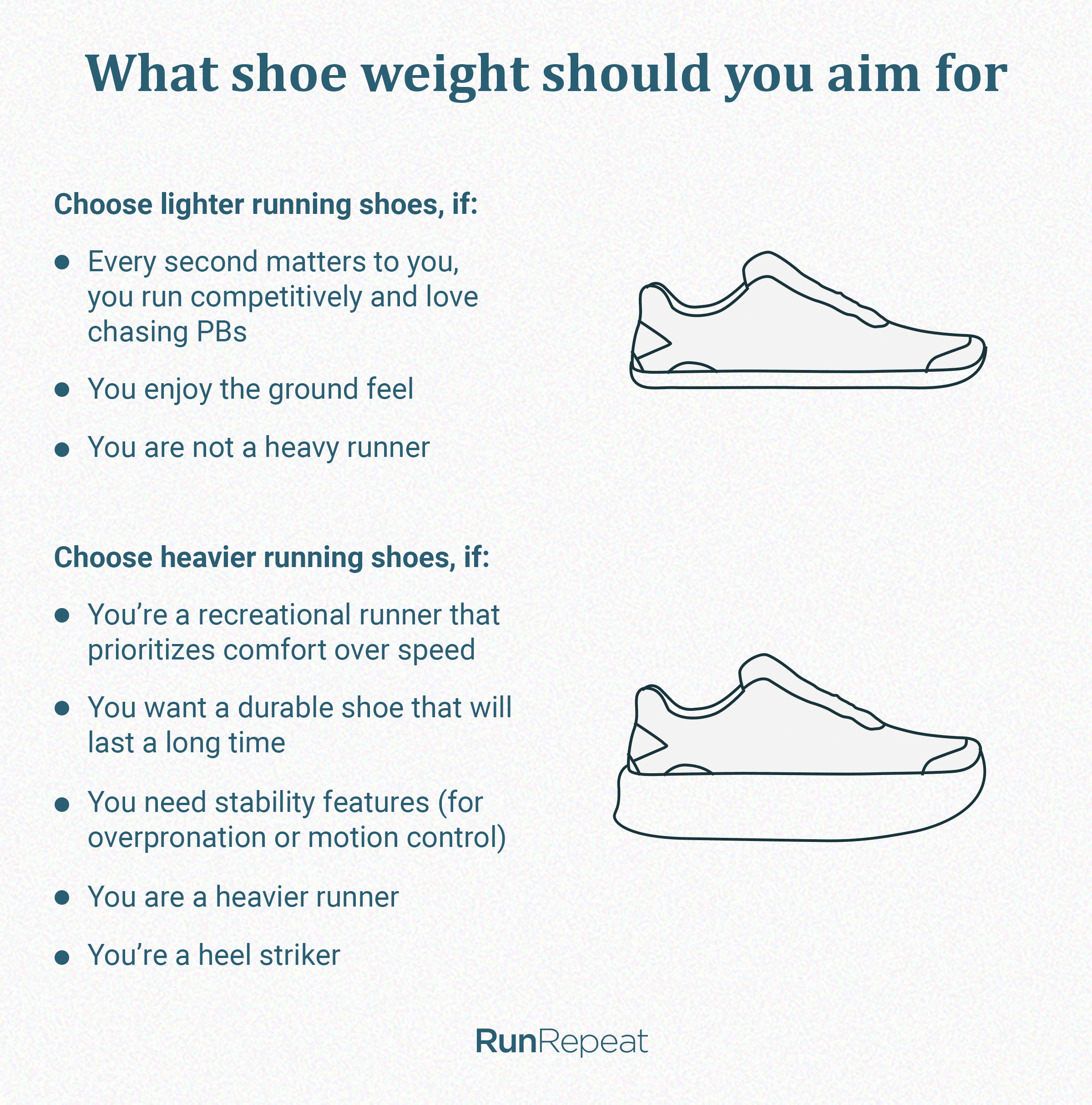
The best advice is to have at least 2 pairs of running shoes in your rotation. One for speed work and races, the other one for daily running, recovery runs, LSD runs.
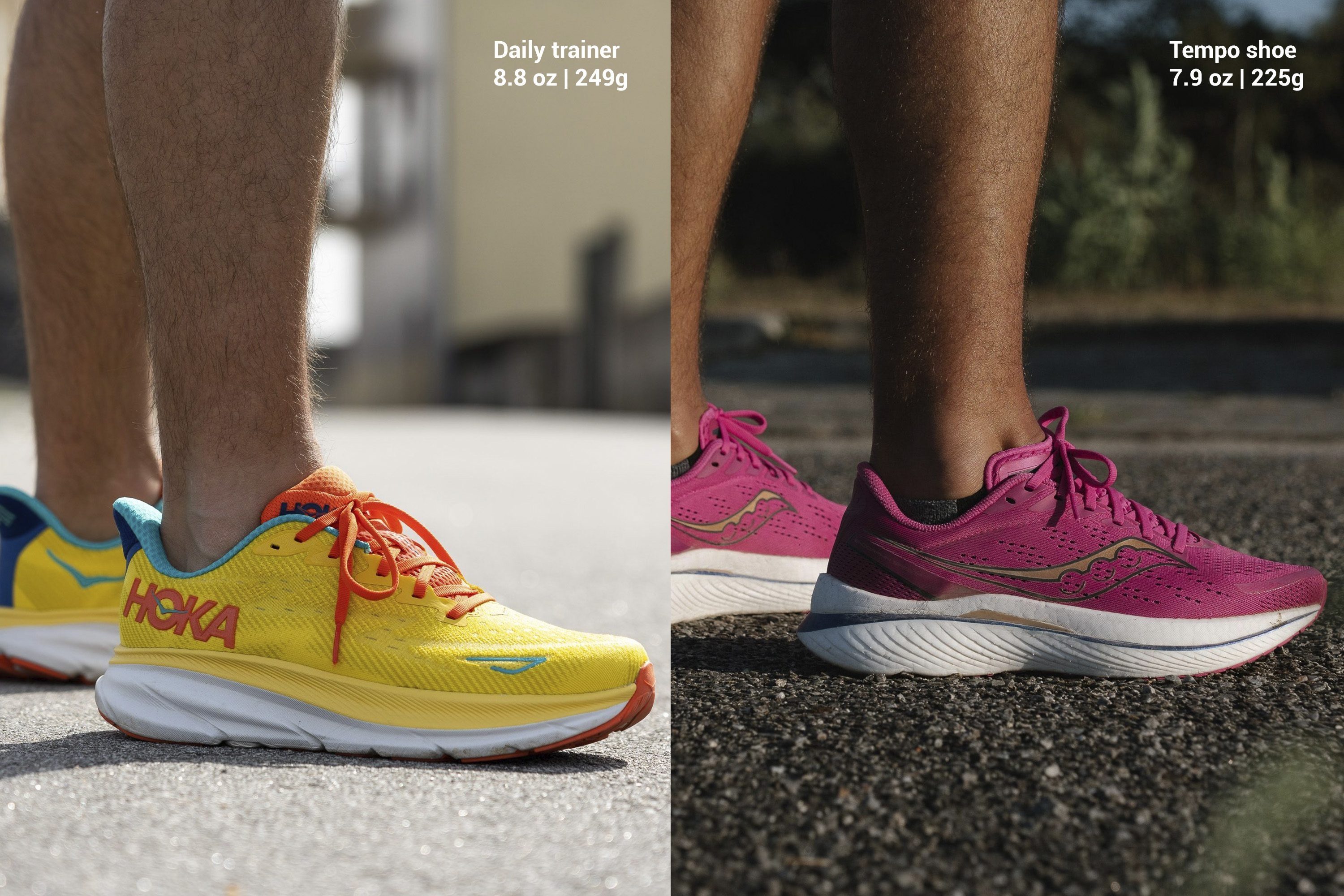
Example from our wear testing: daily trainer Clifton 9 (left) and tempo shoe Endorphin Speed 3 (right)
More advanced runners tend to have even more pairs.
What makes running shoes heavy?
As you might’ve guessed, the biggest chunk of weight is taken by the midsole. Here are 2 examples from our lab, one trail and one road shoe. Usually, heavier shoes have bigger midsoles (higher stacks) and, therefore, allow for more cushioning, comfort and less ground feel.
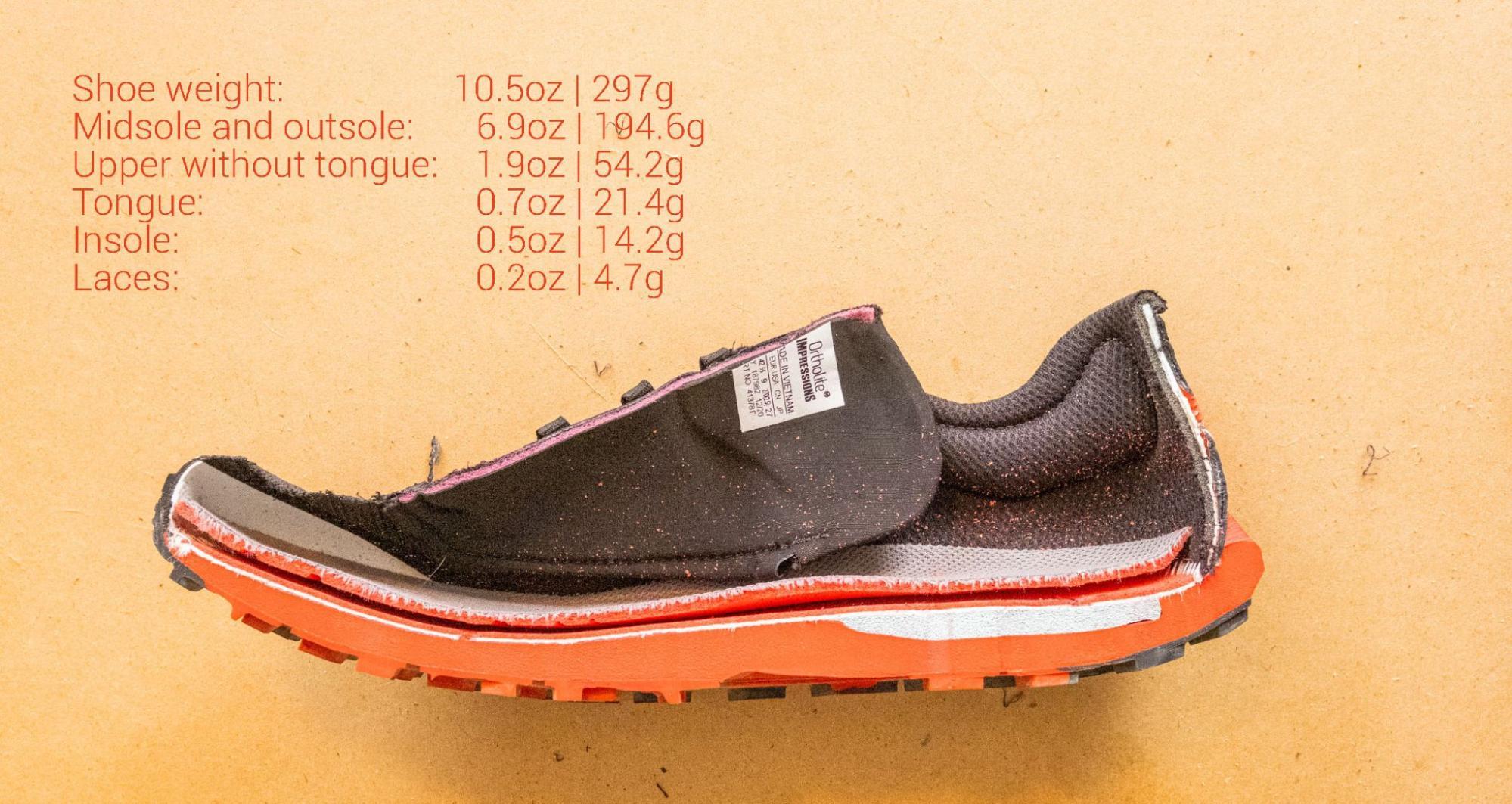
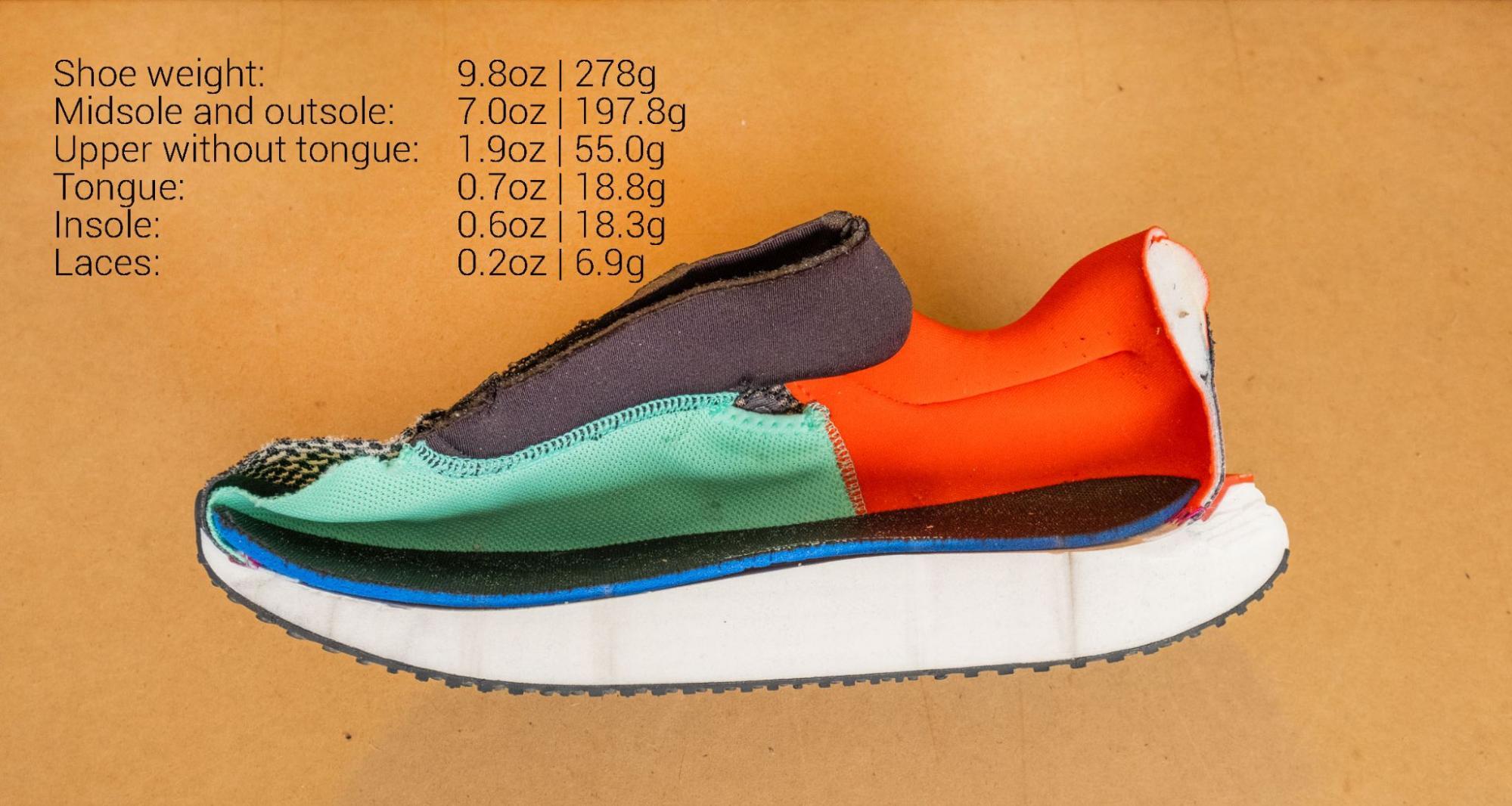
Lightweight does not always mean low-stacked
Usually, there are comparisons between lightweight running shoes and maximalist running shoes. This is important because it implies the tradeoff: dropping the shoe weight is followed by:
- less cushioning (and therefore comfort)
- lower (stack) height
- more ground feel.
Looking at our database,
- shoes with a stack height <30mm weigh on average 9.6oz, while
- shoes with a heel stack height of 30mm and up weigh 10.8oz on average.

This is intuitive, but not always the case because there are maximalist shoes that are simply lightweight (a special hooray for the new technologies).
This is a comparison of all the running shoes in the RunRepeat database:
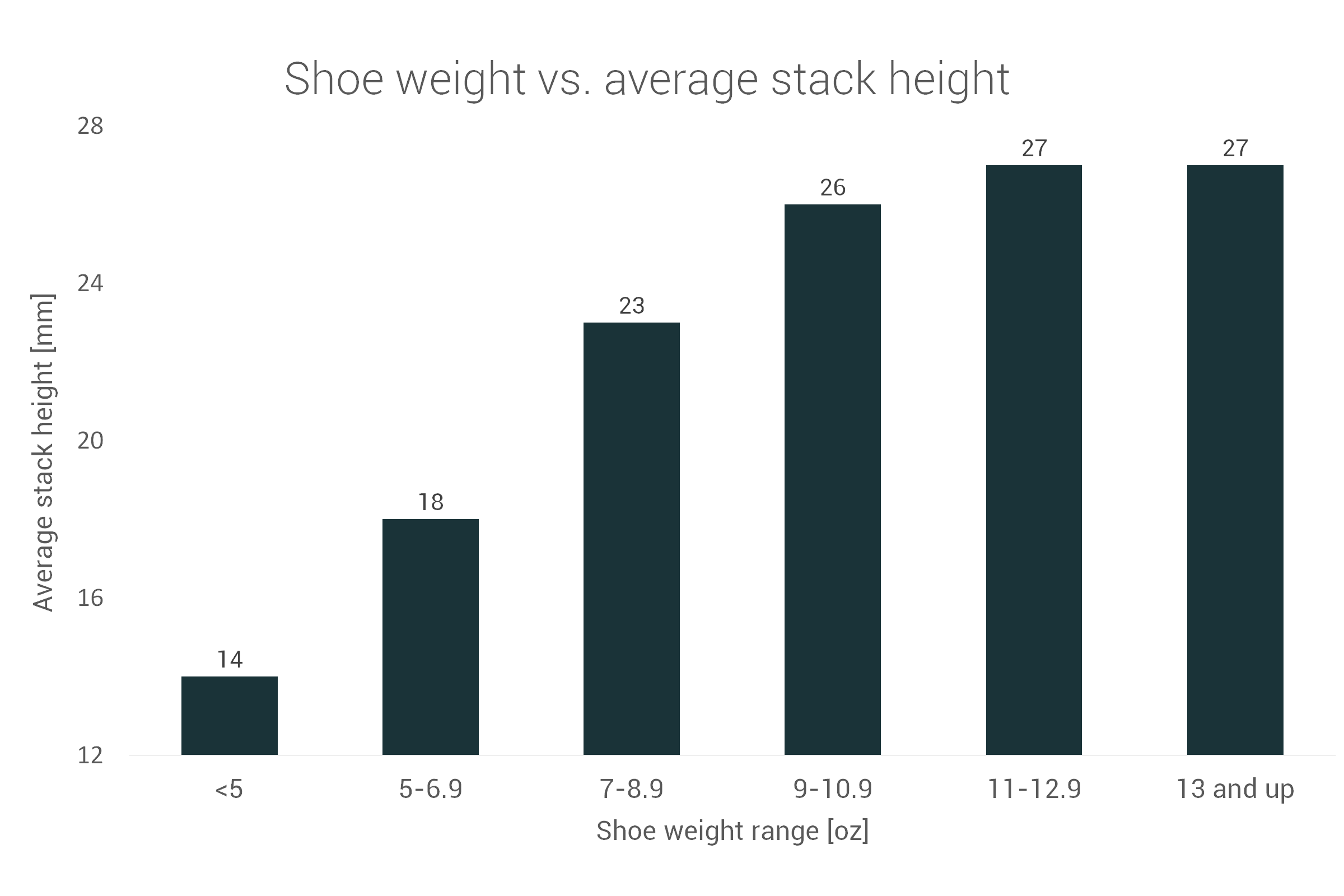
As shown, there certainly are high-stacked running shoes that weigh less even than an average shoe (9.9oz).
The trade-off between speed and shoe weight
There is a time and place for lightweight running shoes as well as for heavier running shoes. This chapter explains why the lightest isn’t always the best (even though it might sound so).

By going lighter, you might remove enough cushioning so that you start using more energy to absorb the shock that would have otherwise been absorbed by the bigger midsole. Not only will your legs have to work more, but you might experience those shoes as less comfortable.
In time and over the course of the running distance, the difference in shoe weight simply adds up. This might mean you want the shoe lighter if the distance is bigger, but in reality, it’s usually the opposite.
- Ideally, for the race day, you’ll look for a lightweight, snug running shoe.
- For your daily trainer, you’ll look for something cushioned, obviously heavier but comfortable.
Adding distance to this equation completely changes everything.
The shorter the distance, the less protection you need, so why would your daily trainers be heavier if you’re running only a few miles per day? Ah, because you want your legs to rest or train, not race.
This is where the speed-weight trade-off enters the scene:
- More comfort and less ground feel mean a higher stack height (more weight, less speed)
- Snug fit, more ground feel and stiffness mean a lower stack height (less weight, more speed)
- More cushioning usually means more weight and less speed. However, the new-tech shoes would not fall into these guidelines easily.
Disclaimer: These are general guidelines. There will always be more fit runners (pro athletes) and sole beginners whose experience and preferences simply would not fit in here.
Example: Minimalist and barefoot runners. Only a really small % of runners can run a 100k in barefoot running shoes. Pro athletes: they are so experienced they can pull a 100 miler in one pair of shoes, rather aggressive and race-ready (less cushioning, lighter, etc.).
Are lighter running shoes loved more?
Do users prefer lighter shoes than experts? Or do experts really like racing flats?
As it turns out, experts like their running shoes as light as possible. Regular users don't mind having some extra weight there:
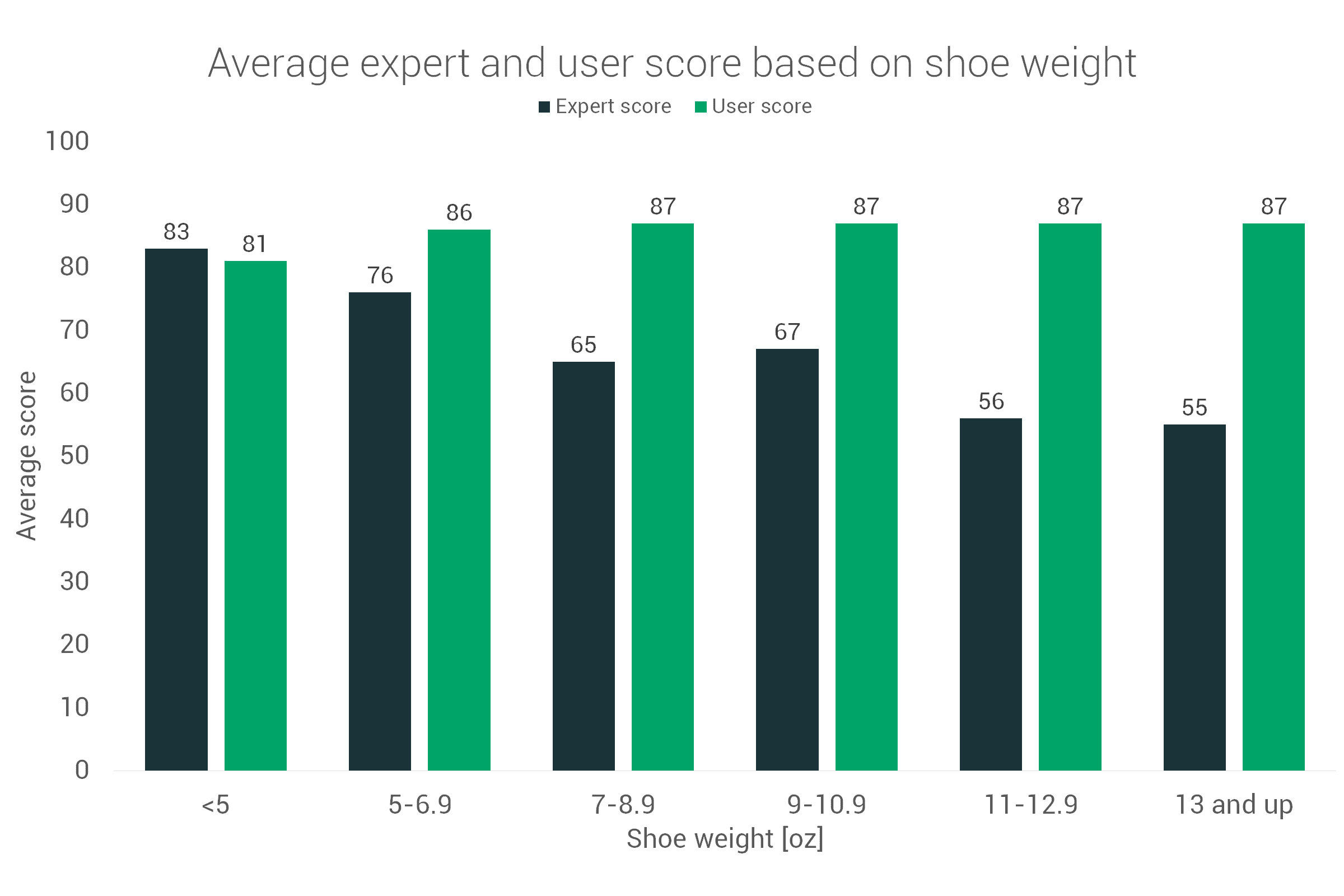
Should you worry about your shoe weight?
Definitely not. It’s on the geekier side of running and usually competitive runners, elite runners and runners with chronic injuries pay attention to it.
Is the 1-2oz difference in shoe weight worth paying for?
Yes, if you’re shooting for your new PB. As described above, 3.5oz lighter shoes meant 0.78% faster times on 3000m.
